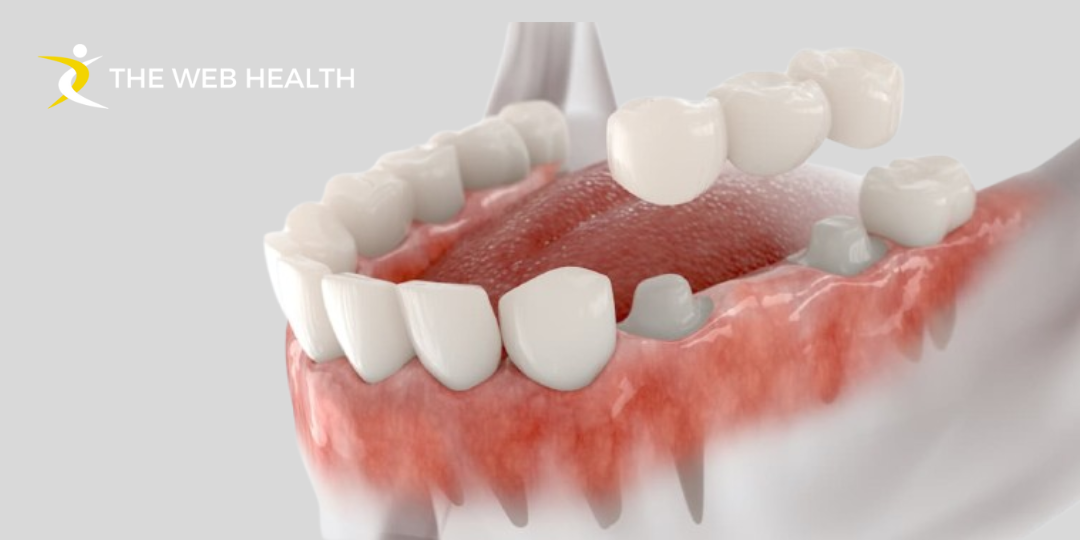Pain after a temporary crown is common, but it’s nothing to ignore. After the procedure, you may experience sharp nerve pain and sensitivity in your teeth, even in your jaw and ears. This can occur because of exposed nerves, a high bite, or irritation from the crown material. If your tooth hurts worse after temporary crown placement, you should understand why and how to relieve it fast.
In this guide, we will discuss the common causes of temporary dental crown pain, how to relieve it quickly, and when to visit a dentist.
Let’s get started.
What Are the Possible Causes of Pain from a Temporary Dental Crown?
Wearing temporary crowns is a common procedure before wearing the final crowns. A little sensitivity is normal, but excessive or piercing pain may be a sign that something is wrong. Here are the top reasons behind temporary crown pain:
Your Crown Doesn’t Fit Properly
A temporary crown is not custom-made like a permanent one. As a result, it may not provide a right fit over your tooth. If the crown is too high, it can added pressure when you bite, leading to discomfort.
A crown that doesn’t fit well can also rub on your gums and irritate them.
The roof of your mouth may occasionally become painful as a result of this irritation, particularly if the inflammation progress to nearby tissues. Consult with your dentist if you have jaw pain or if your bite seems strange.
Tooth Sensitivity and Nerve Exposure
The natural tooth beneath the crown still has nerves. If the crown isn’t properly sealed, air, cold, or heat can get to the nerve, causing a sharp, uncomfortable sensation. Some patients says it hurts to drink hot coffee or eat ice cream. This may typically subside after the temporary crown cement wears off or the permanent crown is placed. A dentist may occasionally need to make adjustments to the temporary crown.
Hidden Tooth Fracture or Damage
Sometimes, a crack or fracture below the crown is responsible. When you chew, a deep crack down to the inner pulp of the tooth can hurt, particularly when releasing your bite. If they are extensive, your dentist might advise a root canal before putting in the permanent crown. A cracked temporary crown may also contribute to pain and should be evaluated.
Teeth Grinding (Bruxism)
If you grind or clench your teeth, especially at night, that can put extra stress on a temporary crown. Because these crowns aren’t as durable as permanent ones, too much pressure can lead to discomfort or even dislodge the crown. If you wake up with sore teeth or jaw pain, wearing a mouth guard while you sleep can help.
Cavities and Infection Under the Crown
It’s normal for the gum tissue to feel a little sore after getting a temporary crown. The procedure can irritate the gum tissue in itself, causing tenderness. But if the pain doesn’t subside after a few days, or it gets worse, it could signal an infection or a poorly fitting crown that’s pushing against the gums.
How Should You Respond to Pain in Your Temporary Crown?
For a day or two following placement, discomfort is common, but persistent pain should not be disregarded. Here’s how to handle it:
1. Check Your Bite
Is there any unevenness in your bite? If your temporary crown is too high, you might be applying too much pressure when you chew. Try lightly tap your teeth together; if the crowned tooth strikes first, the crown might need to be adjusted. This can be fixed with a quick trip to the dentist.
2. Avoid Sticky or Hard Foods
Foods that can dislodge or put additional pressure on temporary crowns should be avoided because they are weaker and do not last as long as permanent ones.
Stay away from:
- Chewy candies
- Hard nuts
- Crunchy snacks
- Ice cubes
Stick to soft foods like yoghurt, soup, and mashed potatoes to avoid pressure on your temporary crown. For a complete list, check out the best foods to eat after tooth removal.
3. Practice Good Oral Hygiene
Keeping your temporary crown clean is the key to avoiding infection. Gently brush and floss the surrounding area. To prevent dislodging the crown, slide the floss out from the side rather than pulling it out straight. Visit your dentist right away to have your temporary crown re-cemented if it falls off.
4. Use a Night guard
Your temporary crown may break or become loose if you grind or clench your teeth at night. Wearing a night guard can protect both your natural teeth and your crown from excess pressure.
Ways to Reduce Pain from a Temporary Crown

While waiting for your dentist appointment, you can try these simple remedies to ease the pain:
-
Over-the-Counter Pain Relievers
Painkillers such as ibuprofen (Advil) or acetaminophen (Tylenol) may help manage pain and reduce inflammation. Use the recommended dosage on the label, and avoid taking painkillers for more than a few days without checking with your dentist.
-
Saltwater Rinse
In addition to relieving sore gums, a warm saltwater rinse can get rid of oral bacteria. Simply swish a teaspoon of salt in some warm water around your mouth for 30 seconds, then spit it out. It’s an easy solution for short-term crown sensitivity.
-
Clove Oil for Numbing Relief
Natural soothing features of clove oil help to relieve pain. Apply a tiny bit to a piece of cotton and apply it to the affected area. Because clove oil is so potent, a small amount goes a long way. This can be beneficial, particularly for nerve pain following temporary crown procedures.
-
Cold Compress for Swelling
Apply a cold compress to the outside of your cheek for 15 minutes at a time if your gums are swollen or sensitive. This can help eliminate the impurities and lessen the inflammation brought on by a temporary crown crack.
-
Avoid Extreme Temperatures
If your temporary crown isn’t perfectly sealed, hot and cold foods can trigger pain. Avoid sudden sensitivity, so stick to lukewarm drinks and meals. A temporary dental crown is more vulnerable to temperature fluctuations than a permanent one.
-
Try a Numbing Gel
Topical numbing gels such as benzocaine can provide temporary relief when applied to the affected area.
When to Visit a Dentist
Most immediate crown pain goes away within few days. Nonetheless, you must consult with your dentist if you encounter:
- Pain that is severe or throbbing and lasts longer than a week
- Pus, rashes, or swelling that could be symptoms of an infection
- The crown feels loose or falls off
- Pain that worsens instead of improving
Potential Risks of Ignoring Pain
According to the American Association of Endodontists (AAE), untreated nerve pain can escalate into severe infections needing emergency treatment. Such as:
- Infection spreading to other areas of the mouth
- Permanent nerve damage, requiring a root canal
- Difficulty eating, leading to nutritional issues
- In some cases, a bad temporary crown can contribute to complications that require urgent attention.
What to Do If Your Temporary Crown Falls Out and Causes Pain
Temporary crowns are designed to be removed easily, so they can occasionally loose or fall out before your permanent crown is ready. If this happens, follow these steps:
-
Retrieve the Crown (If Possible)
If your temporary tooth crown has fallen out, find it and store it in a clean container. Your dentist may be able to reattach it rather than making a new one.
-
Call Your Dentist Immediately
Let your dentist know as soon as possible. They will advise you either you should come in for an appointment or try to reattach it at home using temporary dental crown adhesive.
-
Protect the Exposed Tooth
Without the crown, your tooth is more sensitive to hot, cold, and pressure. To minimize discomfort:
- Avoid chewing on the affected side.
- Stick to soft foods that don’t require much biting or chewing.
- Use over-the-counter pain relievers if the exposed tooth is causing discomfort.
- Ask your dentist, Can I eat if my temporary crown falls out? Usually, soft foods are best when it is restored.
-
Reattach the Crown (If Advised by Your Dentist)
If your dentist tells you to put the crown back on for a short time, do the following:
- Warm water should be used to rinse the inside of the crown and the tooth that is hurting.
- Apply a small amount of dental cement (available at most pharmacies) or toothpaste inside the crown.
- Carefully place the crown back on your tooth, ensuring it sits properly.
- Don’t chew on that side until you can get a permanent fix from your dentist.
- If your crown falls out repeatedly, don’t attempt to fix it yourself multiple times this could damage the tooth underneath.
Last Words
If you experience pain from a temporary crown, basic home remedies such as saltwater rinses, cold compresses, and over-the-counter pain relievers can help in the short term, but we advise seeing your dentist if the pain continues for longer than a week. Many times, temporary crown’s discomfort is just part of the healing process.
Frequently Asked Questions (FAQs)
- Is pain from a temporary crown normal?
Yes, some discomfort is common, especially in the first few days after placement. However, sharp, intense, or prolonged pain may indicate a problem requiring a dentist’s attention. This can sometimes happen if bad crowns are placed improperly.
- How long does pain from a temporary crown last?
Mostly mild pain or sensitivity resolves within 3 to 5 days. If pain persists for more than a week, consult with your dentist.
- Can I drink coffee with a temporary crown?
Yes, but be cautious. Hot drinks can trigger sensitivity, so try lukewarm beverages instead.
- Which medication works best for short-term crown pain?
Ibuprofen (Advil, Motrin) is often recommended for its anti-inflammatory effects. Acetaminophen (Tylenol) is another option.
- Should I refrain from eating while wearing the temporary crown?
Yes, in order to avoid damage or removing the temporary crown, it is best to chew on the other side of your mouth. Additionally, to prevent unintentional removal, brush a temporary crown gently.
- Will a permanent crown stop the pain?
In most cases, yes. If the temporary crown was causing discomfort due to an improper fit, nerve sensitivity, or bite misalignment, a well-fitted permanent crown should resolve the issue.But if the pain doesn’t relieved after the permanent crown is put on, visit your dentist. The temporary crown vs permanent comparison often comes down to how well they’re fitted and secured.


